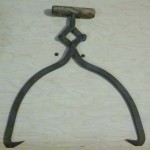- Ice picks
- Ice wagon from Steinle
As summer intensifies, one way to seek relief is with ice-cold drinks. It is very easy to go to the refrigerator and get ice cubes from the freezer or crushed ice from a dispenser on the door of the refrigerator. And for times when more ice is needed to fill ice chests for picnics at parks and beaches, we can buy it by the bag at various places.
It wasn’t always that easy. While the canal was originally built as a mode of transportation, it was also used for the harvesting of ice in the cold winter months. The ice was cut from the frozen canal and then stored in ice houses with sawdust used for packing and insulating. By the turn of the century, however, man-made ice had become available from ice-making plants such as the Steinle Brewery Company. At first this company only made ice for their own use, not for home delivery, but an ad in a May 4, 1905, Delphos Herald lists L.T. Eger selling “Crystal Ice.”
Steinle began home delivery in 1920 when Prohibition put an end to the brewery business. As can be seen in the picture of the delivery wagons, the biggest advantage of man-made ice was its purity. Can you imagine drinking a glass of water containing ice made from canal water? And notice the word “distilled.” Impurities in the water froze at a slower rate than the water so the iceman would remove the water in the center just before it froze and replace it with distilled water, making the ice cleaner than the water used to produce it.
As with milk wagons, horses were used to pull the ice wagon and were used long after automobiles and trucks were available to do the job. The horses learned the delivery routes so well the iceman could stay in the back of the wagon and hop out when the horse stopped at the next location. The iceman would look for the homeowner’s card in the window showing how many pounds of ice were needed that day; and with his ice pick, chop off the desired amount of ice, normally 25, 50, 75, or 100 pounds. Using ice tongs he would hoist the block onto his back and carry the ice to the house and put it in an icebox. Ice wagons were the delight of children who hoped the iceman would toss them a small piece of ice to suck on.
Bob Lause remembers:
“My father, Leonard Lause and his brother Clarence, both worked for the Steinle Brewery works in the early 1940′s. I remember one trip with my dad to deliver ice to the north end railroad yards, to deliver ice to box cars and leave blocks of ice in a wood box beside the roundhouse for the crews to chip ice for their water jugs. Dad would carry blocks of ice (50#) I guess, up the ladder on each end of the box cars and drop the ice in a hatch in the opposite diagonal corner of each car, to cool the food in the cars as the train traveled down the railroad. The cars had hatches open that scooped air in for the direction they were traveling. Dad had a holster on his belt for his ice pick and handled that pick like it was a part of him.”
As with many things, the era of the iceman came to an end and is now just another piece of nostalgia. But that’s why we have museums. To preserve the past for the next generation and fondly remember what it was like “in the good old days.” The Canal Commission museum is open every Thursday from 9 to noon and every Saturday and Sunday from 1 to 3 or by appointment. Hope to see you there soon!
Printed in the Delphos Herald July 13, 2013















I never knew that ice used to be chipped away from canals and stored for the summer! I just realized that without refrigeration, there would be essentially no way to create ice in the summer. I see you mentioned the use of sawdust to store the ice. How did this help insulate and keep the water frozen?
Sawdust is a non-conductor of heat and was readily available from the many sawmills in the area.